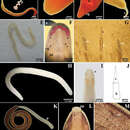en
names in breadcrumbs


(from Coe, W. R. (1901). Papers from the Harriman Alaska Expedition. XX. The nemerteans.. Proc. Wash. Acad. Sci.. 1-110.)
The genus Amphiporus includes mostly rather stout, solid, often flattened forms, usually of considerable size, which are capable of an almost incredible amount of extension and contraction. A few forms, however, are long and cylindrical, even when contracted, but others can contract until the body becomes almost barrel-shaped. The worms can neither swim nor roll up spirally.
(from Allan Hancock Pacific expeditions vol. 1 1943)
Genus AMPHIPORUS Ehrenberg
This genus appears to be represented on the North Pacific coast by at least 17 species, although the generic status of A. gelatinosus is in doubt and there is some question about the specific distinction of A. pacificus and A. rubellus. Only one of these 17 species has been reported from other parts of the world.
Key to Species
1. Body very gelatinous, with an enormous development of body parenchyma. Body short and broad ; ocelli large, 30 or more on each side of head ; cerebral sense organs extremely small, situated in front of brain....A. gelatinosus
1. Body contains only a moderate amount of parenchyma....2
2. Body very slender; white or lightly tinted with red or yellow, without spots....3
2. Body not very slender ; color red, brown, purplish, orange, deep yellow, or spotted....5
3. Blood vessels bright red ; stylet basis very slender ; ocelli in single row on each side of head....cruentatus
3. Blood vessels not red ; stylet basis truncate conical or pear shaped; ocelli in several irregular rows or groups....4
4. With 2 or 3 pouches of accessory stylets....imparispinosus
4. With 6-12 pouches of accessory stylets....formidabilis
5. Central stylet not more than half as long as basis....6
5. Central stylet nearly as long as basis or longer....7
6. Central stylet about yi as long as massive, elongated, conical basis....macracanthus
6. Central stylet about half as long as nearly cylindrical basis....tigrinus
7. Central stylet about twice as long as basis....8
7. Central stylet nearly equal to basis in length....9
8. Dorsal surface brown or reddish, with 2 conspicuous spots of darker color on head; 14-16 proboscidial nerves....bimaculatus
8. Dorsal surface thickly mottled with dark brown dots and blotches; 12 or 13 proboscidial nerves....punctatulus
9. Dorsal surface mottled with deeply pigmented spots....10
9. Dorsal surface without conspicuous spotting....11
10. Cerebral sense organs anterior to brain....nebulosus
10. Cerebral sense organs beside brain....occidentalis
11. Dorsal surface brown, purple, or red....12
11. Dorsal surface yellow....flavescens
12. Dorsal surface brown or purple....13
12. Dorsal surface red or reddish.....15
13. Basis rather slender and conical.....14
13. Basis broad and bell shaped.....fulvus
14. With angular white spot on each side of head; ocelli grouped into 2 separate clusters on each side of head; 17-20 proboscidial nerves....angulatus
14. Without white spots on head; ocelli not separated into distinct clusters; 15 proboscidial nerves....paulinus
15. With 4-8 ocelli on each side of head; 10-12 proboscidial nerves....californicus
15. With 10-20 ocelli on each side of head ; 14 proboscidial nerves....16
16. Dorsal surface reddish brown....pacificus
16. Dorsal surface flesh color, orange, or red....rubellus
(from Coe, W. R. (1901). Papers from the Harriman Alaska Expedition. XX. The nemerteans.. Proc. Wash. Acad. Sci.. 1-110.)
Provided with a single, well-developed central stylet, with a cartridge-shaped basis, and with two or more pouches of accessory stylets. The proboscis sheath usually reaches nearly or quite to the end of the body.
(from Coe, W. R. (1901). Papers from the Harriman Alaska Expedition. XX. The nemerteans.. Proc. Wash. Acad. Sci.. 1-110.)
Usually present in very considerable numbers. A few forms are without eyes, and a few others have but a single pair--there are never 4. The eyes do not extend far behind the brain.
Cerebral sense organs:Usually well developed. Their position is most commonly in front of the brain, but they are sometimes beside or even behind the ganglia.
Amphiporus is a genus of nemerteans belonging to the family Amphiporidae.[1]
The genus has cosmopolitan distribution.[1]
Species:[1]
Amphiporus is a genus of nemerteans belonging to the family Amphiporidae.
The genus has cosmopolitan distribution.